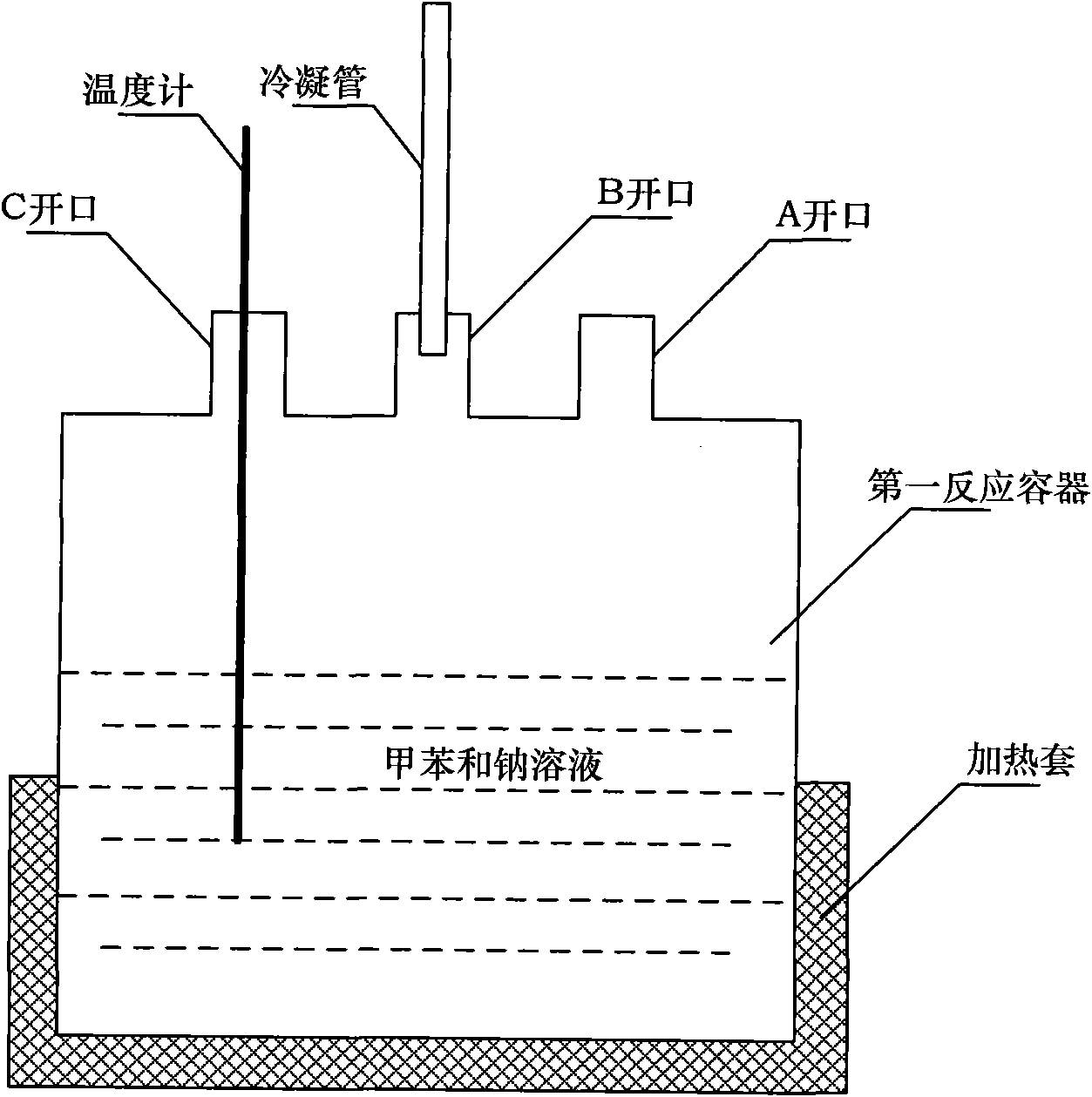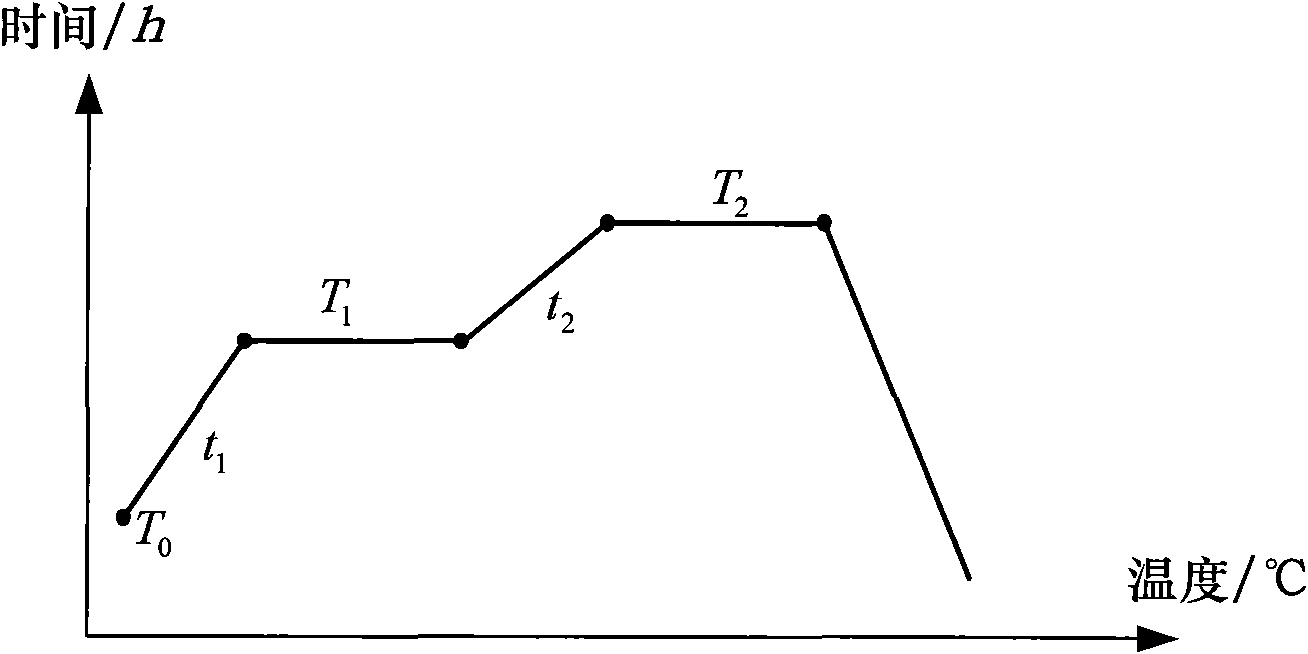Manufacturing method of SiC-SiBCN nucleated glass
A kind of glass-ceramic and a technology of manufacturing method, which are applied in the field of manufacturing SiC-SiBCN glass-ceramic
- Summary
- Abstract
- Description
- Claims
- Application Information
AI Technical Summary
Problems solved by technology
Method used
Image
Examples
Embodiment 1
[0057] Step 1: Preparation of anhydrous toluene
[0058] Toluene C 6 h 6 and sodium Na are loaded into the first reaction vessel through the opening of A, refluxed at a temperature of 110°C (measured by a thermometer in real time) to remove trace water in the toluene, and then distilled at 112°C (measured by a thermometer in real time). Obtain anhydrous toluene; Add 5g of sodium in the toluene of 100ml;
[0059] Step 2: Prepare PCS-toluene solution
[0060] Dissolve polycarbosilane (PCS) in the anhydrous toluene prepared in step 1 to form a PCS-toluene solution; add 1 g of polycarbosilane to 1 ml of anhydrous toluene;
[0061] Step 3: Prepare PBS-toluene solution
[0062] Dissolve polyborosilazane (PBS) in the anhydrous toluene prepared in step 1 to form a PBS-toluene solution; add 1ml of polyborosilazane (PBS) to 1ml of anhydrous toluene;
[0063] Step 4: Precursor polymer alloy preparation
[0064] Mix the PCS-toluene solution prepared in step 2 and the PBS-toluene sol...
Embodiment 2
[0074] Step 1: Preparation of anhydrous toluene
[0075] Toluene C 6 h 6 and sodium Na are loaded into the first reaction vessel through the A opening, refluxed at a temperature of 108°C (measured by a thermometer in real time) to remove trace water in toluene, and then distilled at 112°C (measured by a thermometer in real time). Obtain anhydrous toluene; Add 3g of sodium in the toluene of 100ml;
[0076] Step 2: Prepare PCS-toluene solution
[0077] Dissolve polycarbosilane (PCS) in the anhydrous toluene prepared in step 1 to form a PCS-toluene solution; add 0.5 g of polycarbosilane to 1 ml of anhydrous toluene;
[0078] Step 3: Prepare PBS-toluene solution
[0079] Dissolve polyborosilazane (PBS) in the anhydrous toluene prepared in step 1 to form a PBS-toluene solution; add 0.5ml polyborosilazane (PBS) to 1ml of anhydrous toluene;
[0080] Step 4: Precursor polymer alloy preparation
[0081] Mix the PCS-toluene solution prepared in step 2 and the PBS-toluene solution ...
Embodiment 3
[0089] Step 1: Preparation of anhydrous toluene
[0090] Toluene C 6 h 6 and sodium Na are loaded into the first reaction vessel through the opening of A, and reflux is carried out at a temperature of 105° C. (measured by a thermometer in real time) to remove trace water in toluene, and then distilled at 110° C. (measured by a thermometer in real time). Obtain anhydrous toluene; Add 1g of sodium in 100ml of toluene;
[0091] Step 2: Prepare PCS-toluene solution
[0092] Dissolve polycarbosilane (PCS) in the anhydrous toluene prepared in step 1 to form a PCS-toluene solution; add 0.1 g of polycarbosilane to 1 ml of anhydrous toluene;
[0093] Step 3: Prepare PBS-toluene solution
[0094] Dissolve polyborosilazane (PBS) in the anhydrous toluene prepared in step 1 to form a PBS-toluene solution; add 0.1ml polyborosilazane (PBS) to 1ml of anhydrous toluene;
[0095] Step 4: Precursor polymer alloy preparation
[0096]Mix the PCS-toluene solution prepared in step 2 and the PB...
PUM
| Property | Measurement | Unit |
|---|---|---|
| Grain | aaaaa | aaaaa |
Abstract
Description
Claims
Application Information
 Login to View More
Login to View More - R&D Engineer
- R&D Manager
- IP Professional
- Industry Leading Data Capabilities
- Powerful AI technology
- Patent DNA Extraction
Browse by: Latest US Patents, China's latest patents, Technical Efficacy Thesaurus, Application Domain, Technology Topic, Popular Technical Reports.
© 2024 PatSnap. All rights reserved.Legal|Privacy policy|Modern Slavery Act Transparency Statement|Sitemap|About US| Contact US: help@patsnap.com










